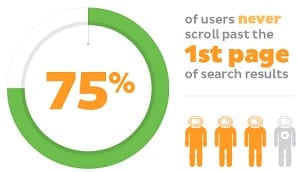Driving traffic to your brokerage’s website organically is one of the most crucial drivers of growth. How to do it? Here are some tips courtesy of Adinah Brown, content manager at Leverate.
“Google’s mission is to organize the world’s information and make it universally accessible and useful.”

Driving traffic to your brokerage’s website organically is one of the most crucial drivers of growth. However, with Google changing SEO rules constantly, ranking amongst the first places and maintaining your coveted spot is no easy feat.
In this article, we’ll walk you through some basic steps needed to optimize your brokerage’s website and improve its ranking on Google.
1. Analyze your present status.
As in every other aspect in your marketing campaign, in order to successfully move forward and improve, you need to know where you are. There are multiple tools to help you asses the current search ranking of your website, all you have to do is… you guessed it… Google it. But to make your life a smidge easier, check out Alexa, SimilarWeb or some of the many other website comparison tools. Use their search engine ranking tool to find out how your brokerage’s website is currently ranking and to compare its ranking with that of your competitors. Another aspect of your site that should be assessed is speed, since Google includes speed in its algorithms to reward and penalize sites.
2. Track your traffic.
Knowing where your visitors are coming from and why, can help you optimize your site for organic website traffic growth. Tools like Google Analytic and Similar Web can help you track certain Key Performance Indicators (KPIs) so you can assess how well your website is serving your goals. Some of the KPIs you should be tracking are number of site visits (total and unique), CTR from your various promotions, banners, etc. Using Google’s URL builder is a phenomenal way to track visitors to your site from each piece of content individually.
Conversion rate. Using Google Analytics’ flow charts can help you see where your users are going within your website and determine whether they are converting. Conversion can be measured by users signing up for your newsletter, filling out a contact form or downloading an e-book. Make sure your conversion goals are in line with your website’s design.
Time on site is an important indicator, but should be analyzed in line with your goals. A long time on site is not always a positive indicator. If your users arrive to a landing page in which you prompt them to click on a download button and they do, they have in essence converted quickly, but have spent little time on your site. In this case, short time on site is a good sign that your conversion process is effective.
The keywords that are leading to your site are another important thing to monitor when tracking traffic to your website. Are these keywords in line with your message? Are visitors arriving to your site based on keywords that are coherent with your offering?
3. Look for penalties.
A few years ago, posting links on other websites and commenting on other blogs would bring your site a higher ranking. Today, Google’s algorithm penalizes websites for placing spammy comment links. Unnatural links can hurt your ranking rather than helping it. Do a search of your website’s backlinks, no-follow links and follow links (you should have a mix) and if you find any unnatural links, ask the webmasters to remove them. If you are unsuccessful at getting negative links removed, use the ‘disavow links tool’ offered in the Google Webmaster Tools.
4. Research your Keywords.
Research your market’s keywords. It is important to find out how your company’s website is being found, as well as your how your competitor’s website is being found.
5. Use Keywords in your content.
Once you determine what keywords are being used to find you and your competitors, you can make good use of them by implementing them naturally in your content. Knowing your user’s intent when they are searching for the products and services you provide, means you can effectively target them with those keywords. Infuse your content with these keywords in a natural way in order to guide visitors through the conversion funnel and make sure the content is regularly updated.
Best practices for use of keywords in your content include:
- Use keywords in your headlines in a way that they are catchy and share-worthy, but not click-bait. Use countdowns, such as top 10s, best 5, etc. Odd numbers tend to perform better. Ask questions.
- Always edit your meta title and meta description to fit your goals.
- Share stories.
- Include interesting data, such as statistics or news.
- Always include a CTA.
6. Use links the correct way.
Contact companies relevant to your industry with whom you have done business and offer to provide them with a testimonial. They will gladly accept adding a link to your website next to your provided testimonial, making this a win-win situation. Offer your services to a charity or donate your products. They will add a link to your site on their website in exchange.
7. Use Alt-tags.
Video and images are becoming increasingly popular, surpassing a text’s performance 9 out of 10 times. When using video or images, always describe them using alt tags or alternative text descriptions to make sure they contribute to your ranking.
